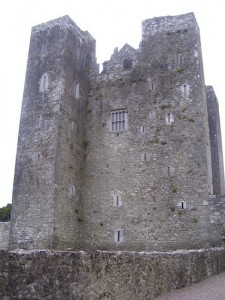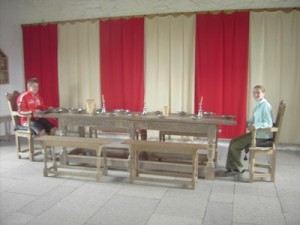 Time goes quite fast, I have been in Ireland for nearly two months. Last weekend I went to visit the Barryscourt Castle, located near the village of Carrigtwohill.
Time goes quite fast, I have been in Ireland for nearly two months. Last weekend I went to visit the Barryscourt Castle, located near the village of Carrigtwohill.
It is a fine example of an Irish tower house with lots of defensive features such as murder hole, crenulations and stumble steps can be seen. The visit lasted one hour and was very interesting and the guide was very pleasant. The man told me that in the past there was a very important link between the castle and Fota. Indeed Fota Island was the property of the Smith-Barry family who were descendents of Philip de Barry. The original Barry family seat at Barryscourt Castle was built in the 15th century. The motto of the family was “Boutez en Avant”; the same motto is displayed on the main gates to Fota Island Resort and means either “go forward“ and “Advance bodily”.
 In 1746 John Barry married a wealthy English heiress called Dorothy Smith beginning the Smith Barry line, which is also the name of the main function room, the Smith Barry Suite, at Fota Island Resort. I learned that the most common origin of the Barry surname comes from de Barri, a French Norman name which may have been derived from a small village in Normandy known as La Barre (Wikipedia) and here you can see the portrait of Dorothy Smith-Barry that insisted to maintain her Family name.
In 1746 John Barry married a wealthy English heiress called Dorothy Smith beginning the Smith Barry line, which is also the name of the main function room, the Smith Barry Suite, at Fota Island Resort. I learned that the most common origin of the Barry surname comes from de Barri, a French Norman name which may have been derived from a small village in Normandy known as La Barre (Wikipedia) and here you can see the portrait of Dorothy Smith-Barry that insisted to maintain her Family name.
Dorothy Smith was born in 1727. She was the daughter of Hugh Smith and Dorothy Barrett Lennard. She married Hon. John Smith-Barry, son of Lt.-Gen. James Barry, 4th Earl of Barrymore and Lady Anne Chichester, in April 1746.She died in January 1756. From April 1746, her married name became Smith-Barry.
There is also an other link that we can establish between the motto of the Barry’s and the town called Buttevant located on the N20 road between Limerick and Cork and the R522 regional road. As I found on internet that “the origins of the present town are clearly Norman, and closely connected with the settlement of the Barrys from the 13th century. Here they built their principal stronghold in North Cork.”That is also in Buttevant that the 1st steeplechase took place. The steeplechase “is a kind of horse racing that first took place in the United Kingdom, Canada, United States, Australia,France, and Ireland. It derives its name from early races in which orientation of the course was by reference to a churchsteeple, jumping fences and ditches and generally traversing the many intervening obstacles in the countryside.
In Great Britain and Ireland the official term now used for the sport is National Hunt racing. The steeplechase originated in Ireland in the 18th century as an analogue to cross-country thoroughbred horse races which went from church steeple to church steeple, hence “steeplechase”. The first steeplechase is said to have been the result of a wager in 1752 between Cornelius O’Callaghan and Edmund Blake, racing four miles (6 km) cross-country from Buttevant Church to St. Leger Church in Doneraile, in Cork, Ireland.” (Wikipedia).
Following this link I can speak about the Doneraile Wildlife Park that is located 11kms NorthEast of Mallow. “The Park is almost 166 hectares in size. There are many pathways and woodland walkways where you can observe deer herds, cascades. And I learn that Doneraile Court, the former residence of the St. Leger family, is situated within the Park.
But now let’s go back to Barryscourt Castle. During the visit the guide brought us to the main door, the kitchen, the Oubliettes (that’s a kind of dungeon, in French the word :”oubli” means to forget), the room with toilets (garderobe)! We could not go to the Chapel as it was closed at present due to ongoing archaeological research. The doors tend to be very small and the steps can be dangerous and narrow.
 The castle was built over three levels. The ground floor was an exhibition area while on the upper levels there were the Main Hall and the Great Hall with reproductions of furniture and utensils on display. The rooms for parents and children were located upstairs. There is also a garden made in the medieval style ”set out in exactly the same manner as Tower House Gardens would have been designed and maintained in their heyday with an orchard stocked with native fruit trees and a 16th century herb garden surrounded by a wall with corner towers.”
The castle was built over three levels. The ground floor was an exhibition area while on the upper levels there were the Main Hall and the Great Hall with reproductions of furniture and utensils on display. The rooms for parents and children were located upstairs. There is also a garden made in the medieval style ”set out in exactly the same manner as Tower House Gardens would have been designed and maintained in their heyday with an orchard stocked with native fruit trees and a 16th century herb garden surrounded by a wall with corner towers.”
The Castle is open to visitors for four months of the year, from 24th May to mid September and the guided tours, between 10 a.m. and 6 p.m., are free of charge. There is also a café where you can have a drink and bite to eat. It is located in the old farm that was restored to include a restaurant and a craft shop on the ground floor and living quarters for the manager upstairs. In the picture you can see the Great Hall and behind the big table a white and red curtain: colour of the Smith Barry family and of Cork City.
As the castle was unoccupied since the beginning of the 18th century it had fallen into almost a ruin. So in 1988 an American/Irish foundation decided to renovate the Castle as a cultural and tourist centre. The castle is just seven minutes drive from Fota Island Hotel Cork. To finish I would say that I found the castle and the history of the Barry family very interesting and it worth it visiting the castle.
Marion